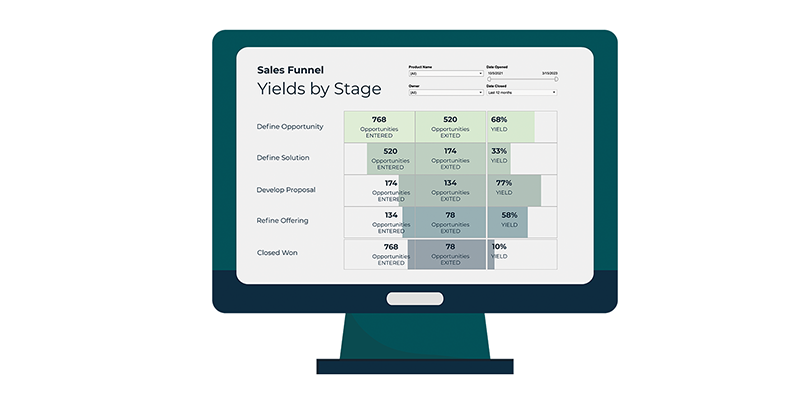The Fallacy of win rates
- 17.03.2023
- Posted by: Tom Tischner
- Category: Innovation

Sales teams around the globe use CRM systems to track and manage #opportunities . The idea is simple enough: Sales personnel can organize its time on driving opportunities to a ‘win,’ and the organization can manage its Operations by looking at a forecast, the cumulative output of the opportunity funnel.
In the last four decades, CRMs have become increasingly more sophisticated, yet Sales Operations managers still struggle to accurately forecast. Why is that?
In most cases we’ve seen, the root cause is what we call the fallacy of win rates. The math goes something like this: Probabilities are used to dilute the expected booking along the trajectory of the funnel. Looking at the picture below, if the total opportunity value at the initial “Define Opportunity” stage were $100k, then diluted contribution form this first stage to the forecast would be $68k.

This win-rate dilution continues for each stage, and adds up the pipeline to the #forecast , or so you’d think.
We’ve hovered into over a hundred funnels that look like this – at best – at the root of which is a basic confusion that CRMs continue to proliferate: Progress #milestones in the funnel are not probabilities. Typically, we see arbitrary assignments for probability, say 10% at the initial stage of defining the opportunity leading to 75%-90% at the final offer refinement. If you’ve done this a lot, you are probably a step ahead and use the win rates as your probabilities, so the 10% of the initial stage would be spot on. You can then calculate the others: 15%, 45%, and 58% at the last stage from our example. This is useful data in that win rates identify bottlenecks in progressing Sales to the sampling stage. But it doesn’t tell us why, and more importantly, it doesn’t help predict if a future opportunity takes the same path through the #funnel .
Problem number one is that win rates are integrative data, which means they reduce much of the noise in the data. The math is simple, calculating the average chance opportunities spend at each stage. But win rates don’t tell much about the spread between opportunities within a #stage. So the average 10% chance of a new opportunity to #result in a booking is just that, the average. We’ve seen data that shows the spread anywhere between 0% (yes, no chance for a particular situation!), and 70%. Consequently, the win rate #KPI is not a leading indicator for a future opportunities. And hence, the prediction, i.e. forecast will be wrong.
It’s obvious that statistics on inaccurate source data will lead an organization astray; it’s the basic GIGO concept. So should you ignore the analytics, toss the data, and just arm wave your way through the next budget cycle? This may sound funny, but you’d be surprised how many organizations do just that. Else, they define the edict that thou shalt increase Sales by 10%, because after all, growth is consistent year over year. Somehow this occurred even in the fall of 2008, against all market odds.
A more measured approach is to look at the funnel population and discern typical data from outliers. And therein lies the art of configuring your CRM: Sales personnel know their customers best. They can tell you the customer’s buying journey. They tend to know how and why decisions are made. By listening carefully, and translating #sales cases into CRM fields that sufficiently characterize the opportunity, this distinction becomes available. After all, not all opportunities are created equal. Why is the customer buying? Existing or new customer? New to the market? Budget allocated? These and many other questions are the heart of qualification. Many CRMs are configured to contain some of these parameters, but they are rarely used to enforce good data stewardship with the sales team, nor are the analytics driving #refinements.
So the first order of business when missing your forecast targets is to clean up your CRM data using the customer’s buying journey. Get the funnel instrumented with the right fields, and you’ll discern what’s leading to a win and what’s stuck. Don’t create a parking lot. The #CRM is not a rolodex (ok, this clearly dates me but I swear it’s a quote from a customer).
The second #fallacy is also related to the customer’s buying journey. Win rates are like your gas gauge: It can tell you how many miles you have left till the tank is empty, which is useful. But it doesn’t tell you how that applies to the road ahead, and how fast you can go to achieve that.
